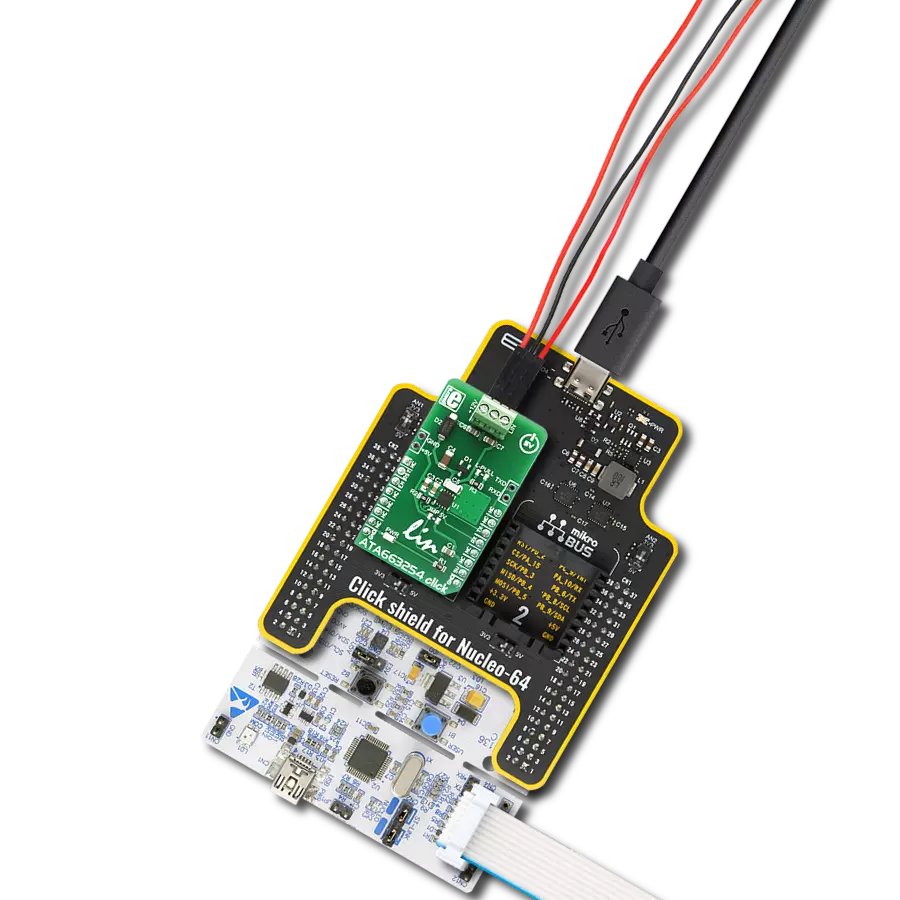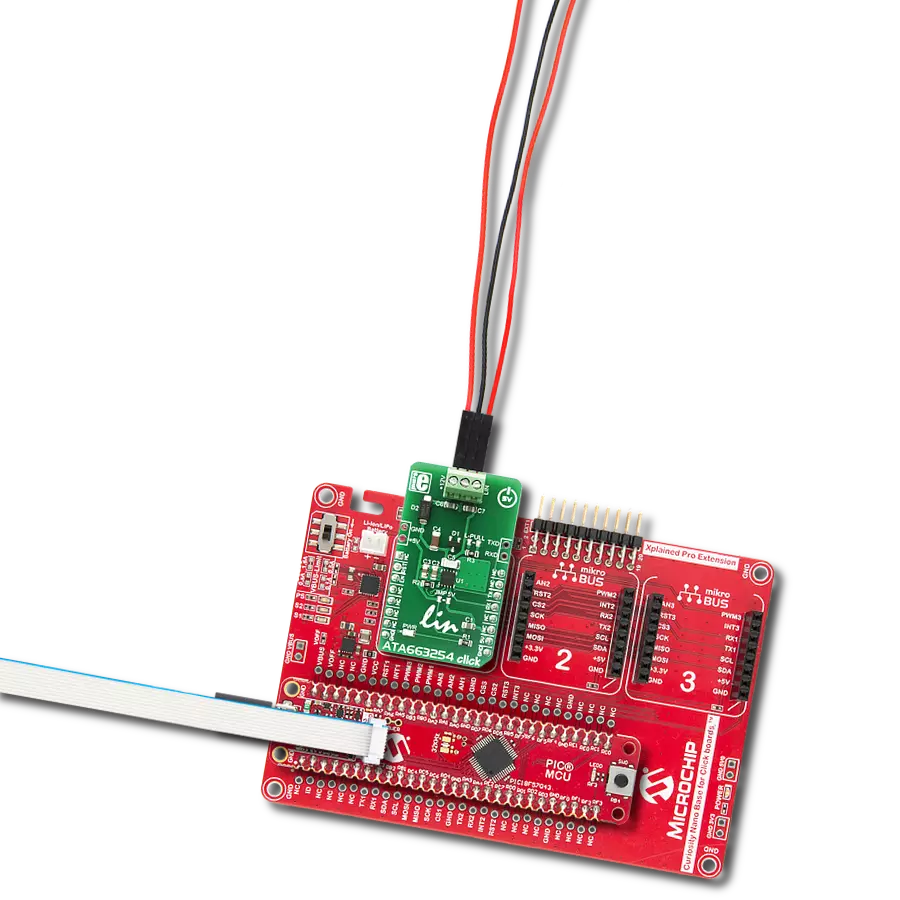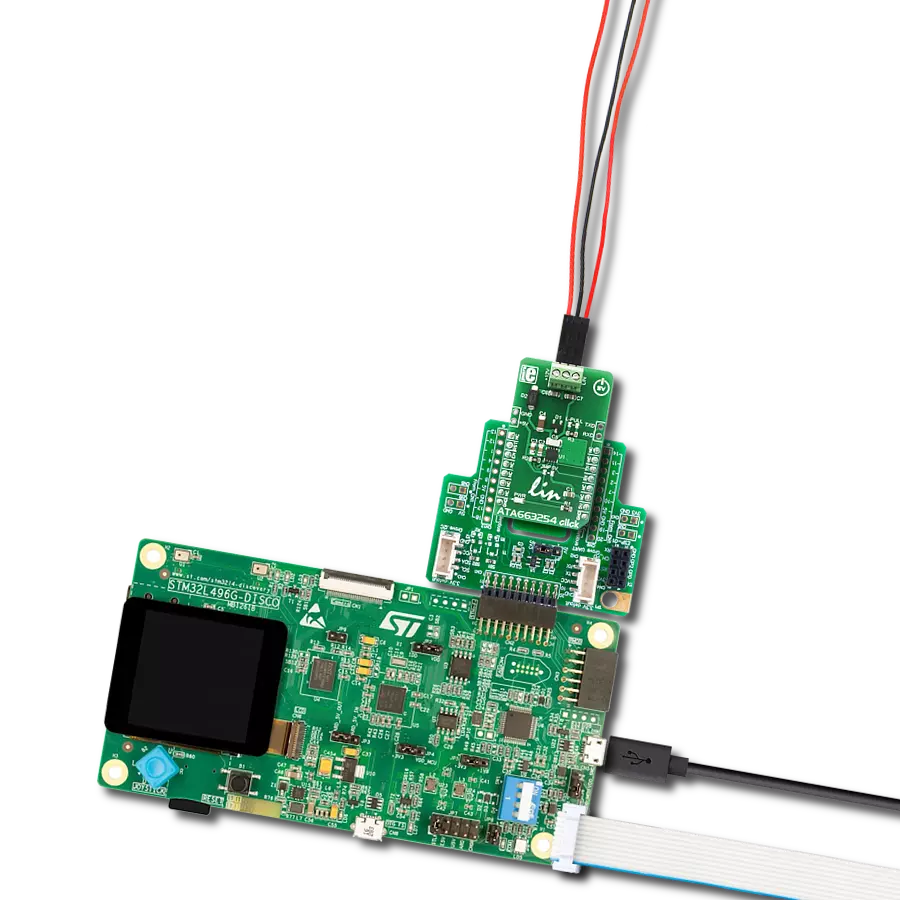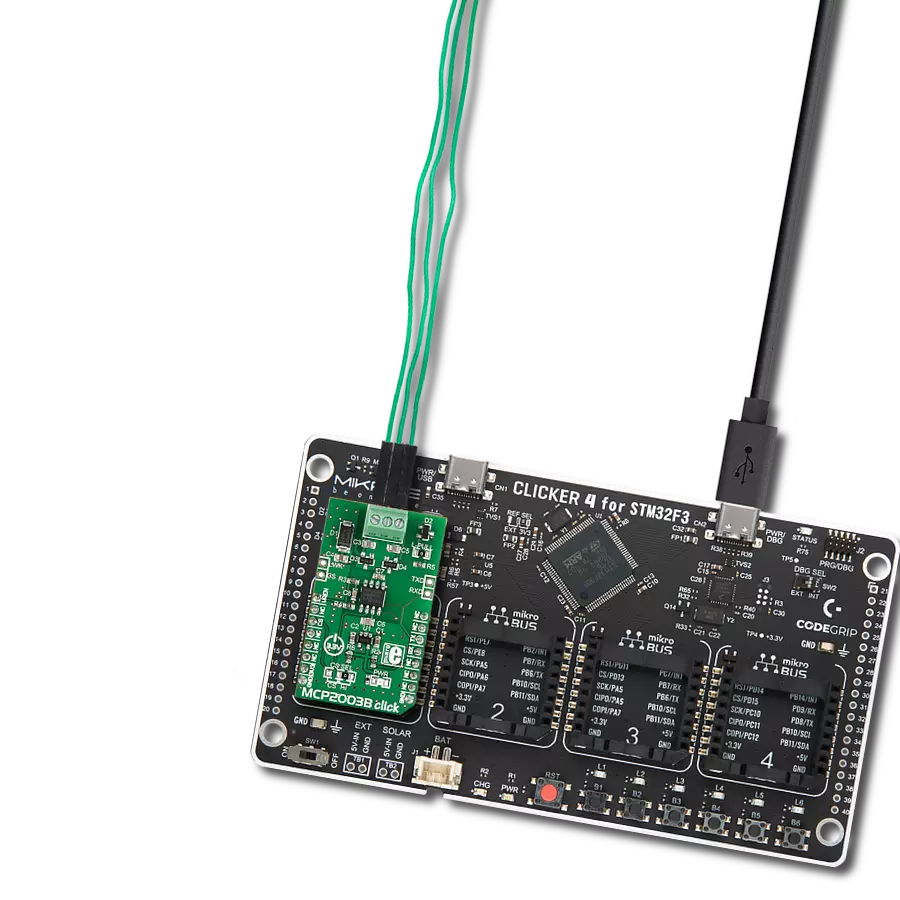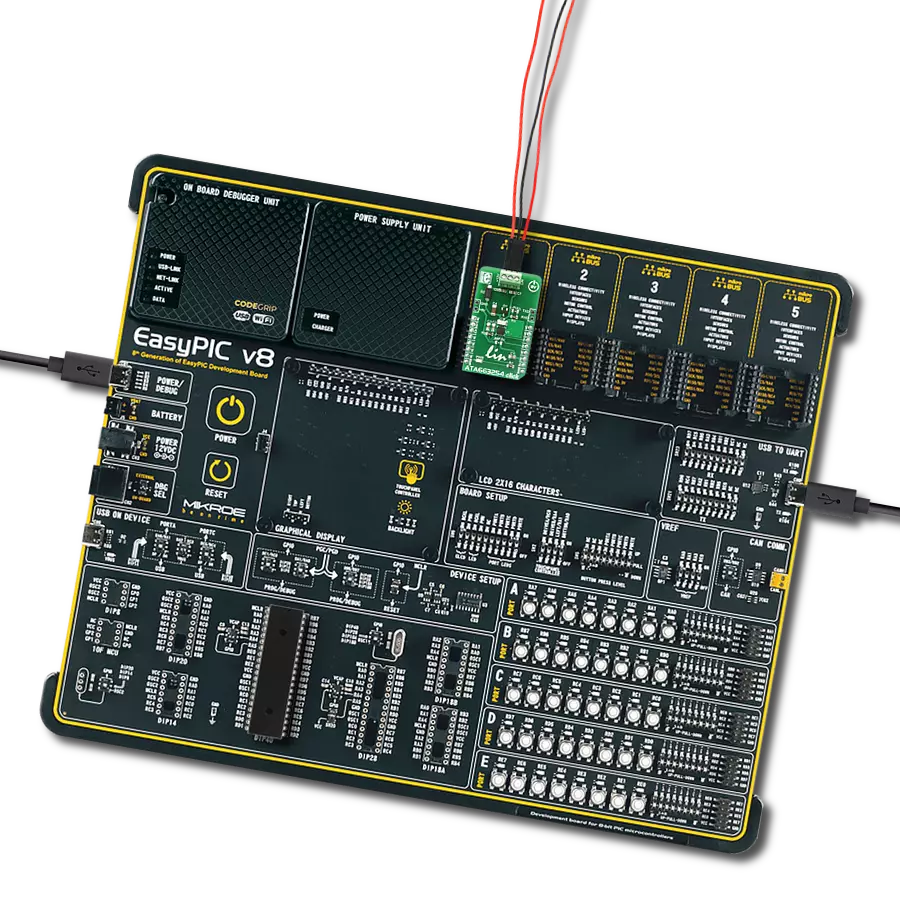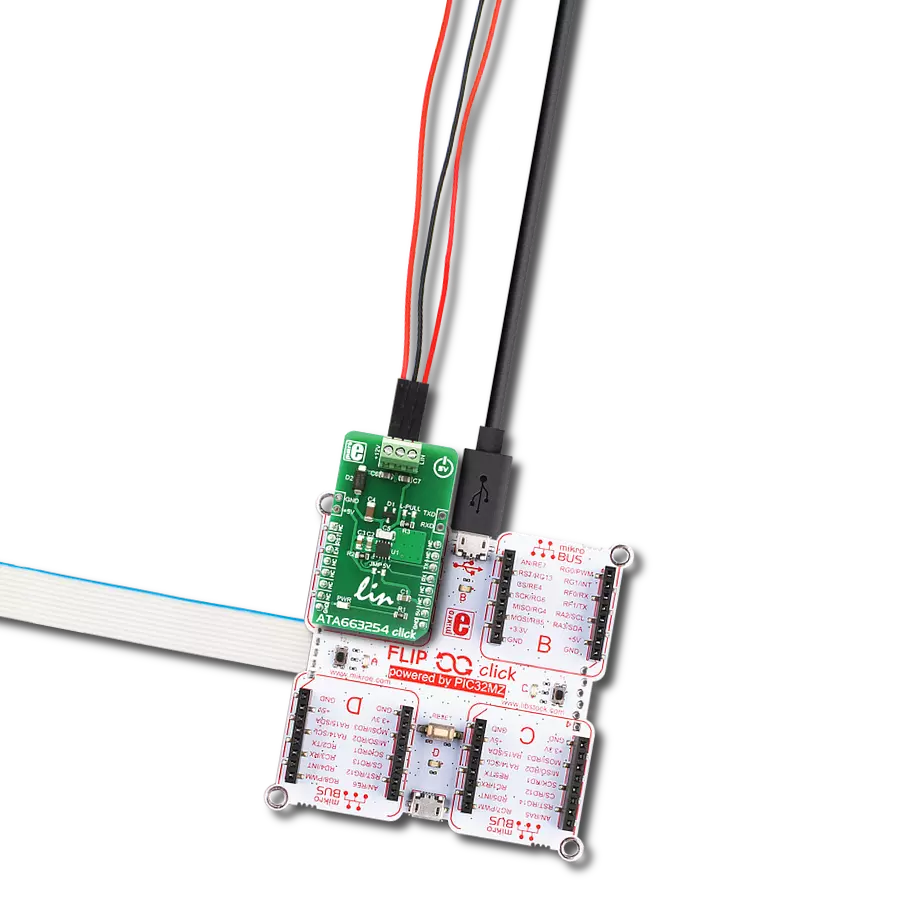Achieve communication within automotive and industrial environments through the LIN (Local Interconnect Network) bus system
A
A
Hardware Overview
How does it work?
MCP2003B Click is based on the MCP2003B, a LIN transceiver from Microchip. This transceiver has both short-circuit and overtemperature protection by internal circuitry. It is designed to operate in an automotive environment and will work in specified transient conditions while meeting all stringent quiescent requirements. The MCP2003B has very high electromagnetic immunity (EMI), 60V load dump protection, high electrostatic discharge (ESD) immunity without TVS, and very high immunity to RF disturbances. It also can work in low-power mode and has an automatic thermal shutdown. One of the protections is direct capacitor coupling robustness without transient voltage suppressor (TVS) of ±35V and ±85V on LBUS, ground loss protection, reverse supply protection, and many more. The MCP2003B Click has four operational modes: Power-Down mode, Ready mode, Operation mode, and Transmitter OFF mode. In Power-Down mode, the lowest power mode, everything except the wake-up pin (LWK on an unpopulated header) is shut down. LIN Bus activity typically changes the device from Power-down to Ready mode in 70μs. In Ready mode, the receiver
is powered up and is ready to receive data while the transmitter is disabled. In Operational mode, all internal modules are operational. The Transmitter OFF mode is reached whenever the transmitter is disabled due to a fault condition, for example, if there is a thermal overload, bus contention, RSD monitoring, and TXD timer expiration. For the typical application as a Master node, the MCP2003B requires the LBUS line of the chip to be connected to the VBB of the LIN BUS, achievable via a populated L-PULL jumper. This jumper can be removed in other scenarios, such as the LIN Slave node. To communicate with the host MCU, the MCP2003B uses a UART interface with commonly used UART RX and TX pins as its default communication protocol to transmit and exchange data. The RX pin is internally monitored and must be at a high level, while LBUS is recessive in Operation mode. Otherwise, an internal fault will be created, and the device will transition to Transmitter Off mode. A voltage regulator sensing circuit, comprised of an MCP1804 regulator and controlled via MCP2003B itself, is connected to the RX pin and internally monitors the RX pin when the LBUS
line is recessive (RX is in a high logic state). If the RX pin is left open, it will not allow the device to switch (or stay) in Operation Mode. That’s why the RX pin is connected to a valid supply, provided by the voltage regulator, through a pull-up 2.2kΩ resistor. A CS SEL jumper can be used to set the chip select pin of the MCP2003B permanently connected to a logic HIGH (set by default), thus enabled all the time, or that the MCU performs this function via the CS of the mikroBUS™ socket. The extra pins LWK (CS on mikroBUS™ socket), CS (Wake-up pin on MCP2003B), TX, and RX are also available above the mikroBUS™ and can be used for external control. The wake-up from power-down mode can be controlled only through the LWK pin of this header. The RXD, TXD, CS, and LWK pins tolerate high voltage. This Click board™ can be operated only with a 3.3V logic voltage level. The board must perform appropriate logic voltage level conversion before using MCUs with different logic levels. However, the Click board™ comes equipped with a library containing functions and an example code that can be used as a reference for further development.
Features overview
Development board
Nucleo-64 with STM32G474R MCU offers a cost-effective and adaptable platform for developers to explore new ideas and prototype their designs. This board harnesses the versatility of the STM32 microcontroller, enabling users to select the optimal balance of performance and power consumption for their projects. It accommodates the STM32 microcontroller in the LQFP64 package and includes essential components such as a user LED, which doubles as an ARDUINO® signal, alongside user and reset push-buttons, and a 32.768kHz crystal oscillator for precise timing operations. Designed with expansion and flexibility in mind, the Nucleo-64 board features an ARDUINO® Uno V3 expansion connector and ST morpho extension pin
headers, granting complete access to the STM32's I/Os for comprehensive project integration. Power supply options are adaptable, supporting ST-LINK USB VBUS or external power sources, ensuring adaptability in various development environments. The board also has an on-board ST-LINK debugger/programmer with USB re-enumeration capability, simplifying the programming and debugging process. Moreover, the board is designed to simplify advanced development with its external SMPS for efficient Vcore logic supply, support for USB Device full speed or USB SNK/UFP full speed, and built-in cryptographic features, enhancing both the power efficiency and security of projects. Additional connectivity is
provided through dedicated connectors for external SMPS experimentation, a USB connector for the ST-LINK, and a MIPI® debug connector, expanding the possibilities for hardware interfacing and experimentation. Developers will find extensive support through comprehensive free software libraries and examples, courtesy of the STM32Cube MCU Package. This, combined with compatibility with a wide array of Integrated Development Environments (IDEs), including IAR Embedded Workbench®, MDK-ARM, and STM32CubeIDE, ensures a smooth and efficient development experience, allowing users to fully leverage the capabilities of the Nucleo-64 board in their projects.
Microcontroller Overview
MCU Card / MCU

Architecture
ARM Cortex-M4
MCU Memory (KB)
512
Silicon Vendor
STMicroelectronics
Pin count
64
RAM (Bytes)
128k
You complete me!
Accessories
Click Shield for Nucleo-64 comes equipped with two proprietary mikroBUS™ sockets, allowing all the Click board™ devices to be interfaced with the STM32 Nucleo-64 board with no effort. This way, Mikroe allows its users to add any functionality from our ever-growing range of Click boards™, such as WiFi, GSM, GPS, Bluetooth, ZigBee, environmental sensors, LEDs, speech recognition, motor control, movement sensors, and many more. More than 1537 Click boards™, which can be stacked and integrated, are at your disposal. The STM32 Nucleo-64 boards are based on the microcontrollers in 64-pin packages, a 32-bit MCU with an ARM Cortex M4 processor operating at 84MHz, 512Kb Flash, and 96KB SRAM, divided into two regions where the top section represents the ST-Link/V2 debugger and programmer while the bottom section of the board is an actual development board. These boards are controlled and powered conveniently through a USB connection to program and efficiently debug the Nucleo-64 board out of the box, with an additional USB cable connected to the USB mini port on the board. Most of the STM32 microcontroller pins are brought to the IO pins on the left and right edge of the board, which are then connected to two existing mikroBUS™ sockets. This Click Shield also has several switches that perform functions such as selecting the logic levels of analog signals on mikroBUS™ sockets and selecting logic voltage levels of the mikroBUS™ sockets themselves. Besides, the user is offered the possibility of using any Click board™ with the help of existing bidirectional level-shifting voltage translators, regardless of whether the Click board™ operates at a 3.3V or 5V logic voltage level. Once you connect the STM32 Nucleo-64 board with our Click Shield for Nucleo-64, you can access hundreds of Click boards™, working with 3.3V or 5V logic voltage levels.
Used MCU Pins
mikroBUS™ mapper
Take a closer look
Click board™ Schematic

Step by step
Project assembly
Software Support
Library Description
This library contains API for MCP2003B Click driver.
Key functions:
mcp2003b_generic_write- This function writes a desired number of data bytes by using UART serial interfacemcp2003b_generic_read- This function reads a desired number of data bytes by using UART serial interfacemcp2003b_set_cs_pin- This function sets the chip select (CS) pin logic state
Open Source
Code example
The complete application code and a ready-to-use project are available through the NECTO Studio Package Manager for direct installation in the NECTO Studio. The application code can also be found on the MIKROE GitHub account.
/*!
* @file main.c
* @brief MCP2003B Click Example.
*
* # Description
* This example demonstrates the use of an MCP2003B Click board by showing
* the communication between the two Click board configured as a receiver and transmitter.
*
* The demo application is composed of two sections :
*
* ## Application Init
* Initializes the driver and logger and displays the selected application mode.
*
* ## Application Task
* Depending on the selected mode, it reads all the received data or
* sends the desired message every 3 seconds.
*
* @note
* The Click boards should be connected as follows: VBB->VBB, LBUS->LBUS, GND->GND.
* The communication power supply voltage provided on VBB pin should be in range from 5.5V to 30V.
* @author Stefan Filipovic
*
*/
#include "board.h"
#include "log.h"
#include "mcp2003b.h"
// Comment out the line below in order to switch the application mode to receiver
#define DEMO_APP_TRANSMITTER
#define DEMO_TEXT_MESSAGE "MIKROE - MCP2003B Click board\r\n"
static mcp2003b_t mcp2003b;
static log_t logger;
void application_init ( void )
{
log_cfg_t log_cfg; /**< Logger config object. */
mcp2003b_cfg_t mcp2003b_cfg; /**< Click config object. */
/**
* Logger initialization.
* Default baud rate: 115200
* Default log level: LOG_LEVEL_DEBUG
* @note If USB_UART_RX and USB_UART_TX
* are defined as HAL_PIN_NC, you will
* need to define them manually for log to work.
* See @b LOG_MAP_USB_UART macro definition for detailed explanation.
*/
LOG_MAP_USB_UART( log_cfg );
log_init( &logger, &log_cfg );
log_info( &logger, " Application Init " );
// Click initialization.
mcp2003b_cfg_setup( &mcp2003b_cfg );
MCP2003B_MAP_MIKROBUS( mcp2003b_cfg, MIKROBUS_1 );
if ( UART_ERROR == mcp2003b_init( &mcp2003b, &mcp2003b_cfg ) )
{
log_error( &logger, " Communication init." );
for ( ; ; );
}
#ifdef DEMO_APP_TRANSMITTER
log_printf( &logger, " Application Mode: Transmitter\r\n" );
#else
log_printf( &logger, " Application Mode: Receiver\r\n" );
#endif
log_info( &logger, " Application Task " );
}
void application_task ( void )
{
#ifdef DEMO_APP_TRANSMITTER
mcp2003b_generic_write( &mcp2003b, DEMO_TEXT_MESSAGE, strlen( DEMO_TEXT_MESSAGE ) );
log_printf( &logger, "%s", ( char * ) DEMO_TEXT_MESSAGE );
Delay_ms ( 1000 );
Delay_ms ( 1000 );
Delay_ms ( 1000 );
#else
uint8_t rx_data = 0;
if ( mcp2003b_generic_read( &mcp2003b, &rx_data, 1 ) > 0 )
{
log_printf( &logger, "%c", rx_data );
}
#endif
}
int main ( void )
{
/* Do not remove this line or clock might not be set correctly. */
#ifdef PREINIT_SUPPORTED
preinit();
#endif
application_init( );
for ( ; ; )
{
application_task( );
}
return 0;
}
// ------------------------------------------------------------------------ END
Additional Support
Resources
Category:LIN



















